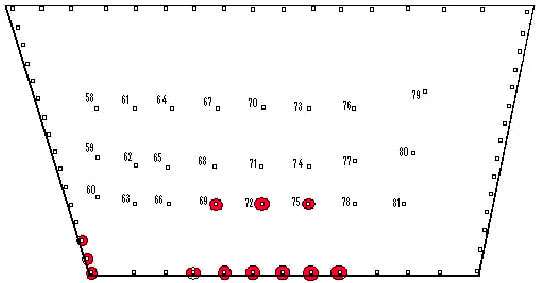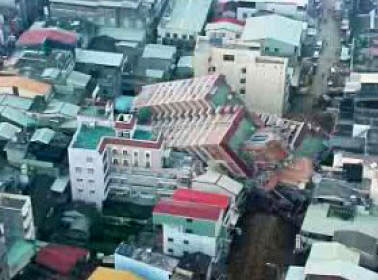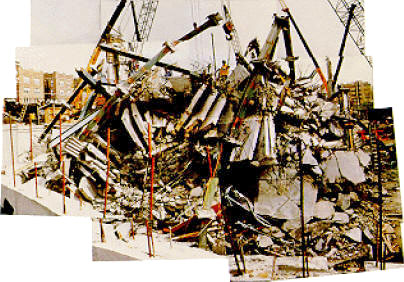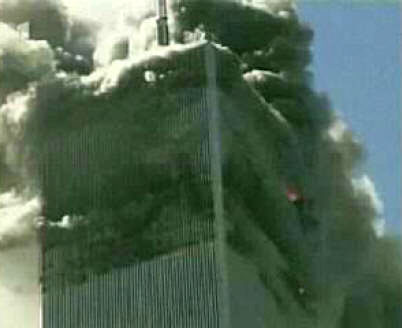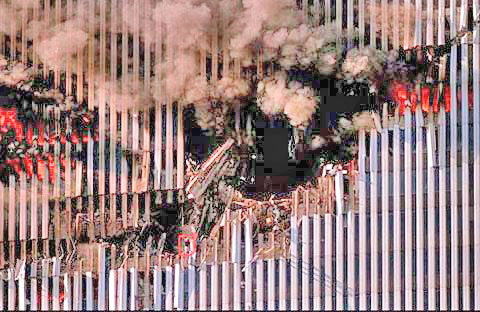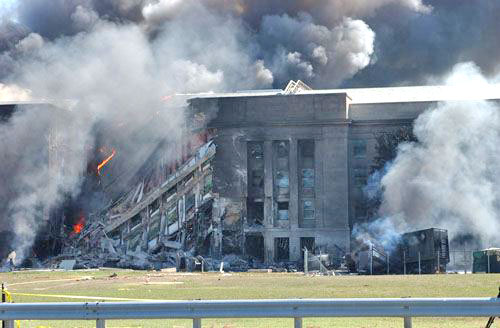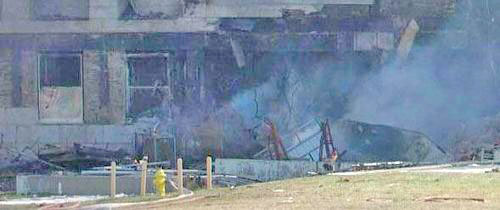by Joe Quinn
January 07, 2006
Contents
Additional Information (PDF files)
Multimedia 

Introduction
After the release of the QFG Pentagon Strike Flash Animation on August 23rd, 2004, a veritable onslaught of new articles were published that sought to dismiss the "no plane at the Pentagon" theory. One such article, that is frequently referenced by certain ’9/11 researchers’ was authored by a member of the forum at the "Above Top Secret" (ATS) website. Interestingly, the article was written just a few weeks after the release of the Pentagon Strike Flash animation, which by then, was winging its way around the world and into the inboxes of millions of ordinary citizens. Perhaps you were one of them...
The claim that promoters of the "no plane at the Pentagon" theory were doing immense damage to the truth/accountability movement was raised in Mike Ruppert’s book Crossing the Rubicon. In a stunning piece of warped logic, Ruppert claimed that, while he is quite convinced that it was not Flight 77 that hit the Pentagon, he chose not to talk about or deal with the subject as part of his overall case for conspiracy because of the "implications".
According to Ruppert, the "implications" are that anyone that suggests that Flight 77 did not hit the Pentagon, is then forced to answer the question as to what actually happened to Flight 77. If that’s the case, then we better just wrap up the whole 9/11 Truth Movement and go home and have a beer.
Ruppert balks at the idea of offering an answer to this question to his readers because, he claims, most people would be unable to accept it, and, he suggests, 9/11 researchers serve only to alienate the public support that they wish to attract by stretching the boundaries of the collective belief system. What Ruppert doesn’t explain is why any member of the public would happily accept that U.S. government officials participated in the slaughter of the passengers on Flights 11 and 175 and the occupants of the WTC towers (as he details in his book) yet would be unable to accept the idea that the same government officials played a part in disposing of the passengers of Flight 77 in a much less imaginative way.
Let’s be honest here, in the context of 9/11 being the work of a faction of the US government and military, the answer to the question as to what happened to Flight 77 if it didn’t hit the Pentagon is quite obvious - Flight 77 and its occupants were flown to a specific destination and “disposed of” by the conspirators. That’s pretty simple; cut and dried; no need for much stretching there!
But, for some reason, Ruppert (and others affected by this paramoralism) seems to think that killing thousands of citizens by crashing airplanes is easier to accept than cold bloodedly murdering them "in person," as it were.
Since Ruppert’s declaration about the "no plane at the Pentagon" theory, many other "9/11 researchers", such as Mark Rabinowitz and Jim Hoffman, have seized upon Ruppert’s idea and even expanded upon it by suggesting that the "no planers" are actually government agents trying to discredit the REAL 9/11 researchers with the ’kooky’ "no plane" theory.
In order to really understand the insidiousness of this patronizing claim that the public could not accept the implications of the idea that a Boeing 757 did not hit the Pentagon, let’s look at the "evidence" as presented by the ATS member that it really was Flight 77 that impacted the Pentagon that bright September morn.
First, however, I would like to make a few observations about 9/11 research in general.
Anyone who takes on the formidable task of digging into the events of 9/11 is immediately at a disadvantage because the US government has already declared the case closed. The government knows how it happened and who did it and have informed the entire world. As a result, there is no possibility of access to the raw data, to the crime scene or analyses of same. Here is where we meet the major obstacle: since the US government is the prime suspect, we cannot simply take as truth everything - or anything - that they say in relation to the case.
Investigation of the 9/11 attacks should be approached like any murder investigation.
-
When confronted with a murder case (like 9/11) and a suspect that has a history of deceit and murder (like the US government and its agencies) and who had an opportunity and a motive to commit the murder, do you take as fact any claims by the suspect that he did not commit the murder?
-
Do you seek to fit the facts around his claim that he did not commit the murder?
-
When you confront evidence that suggests that the suspect is lying about his account of where he was and what he was doing, or you find inconsistencies and logistically impossible scenarios in his account, do you ignore these and focus only on the fact that he said he did not commit the murder and try to find and present evidence that backs up his claim to innocence?
The fact is that researchers coming to the 9/11 investigation after the fact, and after the case has been officially closed, are not only confronted with the task of trying to find out what actually happened - they also face the already well established public belief, by which they themselves are also influenced, that the official story is the truth.
The best approach for any 9/11 researcher with honest intentions is to, if possible, wipe from their minds the official version of events and take the attitude of someone who has just returned from a 5 year trip to the outer reaches of the solar system, during which time they had no communication with planet earth. Start with a beginner’s mind, turn off the sound of all the conflicting voices and their claims, and just LOOK at the evidence without prejudice.
Now, if the person with a truly open mind is given all of the publicly available evidence and has been additionally furnished with knowledge of the effects of airplane crashes and that of missile impacts, what would such a person conclude about the most likely cause of the Pentagon damage? Of course, not all of the evidence was made available to the public, but there is still sufficient visual evidence from "ground zero" (both in terms of place and TIME), to form a pretty good "best guess".
For a definitive conclusion to be reached, the "private" evidence, like the video tapes of the event that the FBI confiscated, would have to be released, and we don’t expect that to happen any time soon. Of course, the fact that the definitive evidence of the videos has not been released is in itself a key piece of evidence that suggests that the official story of what hit the Pentagon is not the real story.
The purpose of this small introduction is to prepare the reader for the fact that, in his attempted rebuttal of the no 757 at the Pentagon theory, the ATS article author, CatHerder, appears to have succumbed to the influence of the mainstream media shills that have incessantly parroted the official government story about what happened on 9/11 for the three years prior to the writing of the article.
As such, he has failed to don the mantle of objective observer of the available evidence that is so crucial to finding the truth, and instead exerts a lot of effort to make the available evidence fit the government claim that Flight 77 hit the Pentagon on the morning of September 11th 2001. Either that, or he/she is part of the "official government cover-up." After you read everything below, you can make a call on that one yourself.
Here is the ATS article as it appears on the ATS site with my comments interspersed in italic text.
Evidence That A Boeing 757 Really Did Impact the Pentagon on 9/11
by "CatHerder", Member, AboveTopSecret.com/forum
September 11th, 2004
Did a 757 hit the Pentagon on 9-11
First let’s start with the factual information available on hand.
The 757-200
As we can see from the freely available information for the Boeing 757 (from the Boeing website). The 757 is a midsized commercial airliner designed for short haul and medium haul routes (Medium Range Transport (MR-TR)), although since its release, and the subsequent discovery of the Wake Vortex it leaves behind the FAA has classified the 757 as a "Heavy" aircraft; the FAA places the 757 in the Geometric Design Classification IV, and an ATC Operation Class C. (source)
The 757-200 dimensions: -
Tail Height: 44 ft 6 in (13.6m)
-
Length: 155 ft 3 in (47.32m)
-
Wingspan: 124 ft 10 in (38.05m)
-
Body Exterior Width: 12 ft 4 in (3.7m)
-
Fuel Capacity: 11,489 us gal (43,490l / 43,490kg)
-
Maximum Takeoff weight: 255,000lb (115,680kg)
-
Typical Cruise Speed: 0.80 Mach (573.6mph / 956kmh)
-
Engines used on a 757: Two 166.4kN (37,400lb) Rolls-Royce RB211-535C turbofans, or 178.8kN (40,200lb) RB211-535E4s, or 193.5kN (43,500lb) RB211-535E4-Bs, or 162.8kN (36,600lb) Pratt & Whitney PW2037s, or two 178.4kN (40,100lb) PW2040s, or 189.5kN (42,600lb) PW2043s. (source1) (source2)
-
Auxiliary Power Unit: Honeywell GTCP331-200

right portion: source2 (height and width notation to graphic added by me)
Next, let’s look at the Pentagon.
The Pentagon
The Pentagon was designed in the early 40’s and was completed in only 16 months on Jan 14, 1943. The shortages of materials required for war production raised many design and construction problems. The use of reinforced concrete in lieu of formed steel for the building made possible a saving of 43,000 tons of steel, more than enough to build a battleship. The use of concrete ramps rather than elevators further reduced steel requirements. Drainage pipes were concrete; ducts were fiber, interior doors were wood. An unusual wall design - concrete spandrels carried to window sill level - eliminated many miles of through-wall copper flashing.(Source1) (Source2)
Recent renovations and upgrades to the building were nearing completion on the side hit on 9-11 and performed reasonably well considering they were not designed to withstand aircraft impact. On September 11, when an American Airlines Boeing 757 crashed into the Pentagon, home of the U.S. Department of Defense (DoD), about 20,000 people were at work in this, the largest office building in the world. Yet according to the DoD casualty update on October 1, only 125 Pentagon employees were killed along with the 64 from the fated airliner. (source - Architecture Week)
The exterior walls had been reinforced with steel beams and columns, bolted where they met at each floor. Some of these reinforced walls very near the point of impact remained in place for a half hour before collapsing, allowing uncounted hundreds to escape. "Had we not undertaken this effort," said Evey at a press briefing on September 15, "this could have been much, much worse."
Now, I’m sure everyone can agree that the above information is a matter of public record, and none of it is incorrect, altered, or misquoted in any way to support either side of the case. It is all merely factual information that we will refer to in the following sections.
[Note: I was unintentionally misleading in a previous post when I said the Pentagon didn’t use a steel beam construction - while that is still true for the original design, it was reinforced in various areas during the upgrades to include steel beams and columns in some areas of the renovations.]
Quoted from ArchitectureWeek.com: In addition to major overhauls of the mechanical and electrical systems, the Wedge One renovation included the fire sprinklers, automatic fire doors, and the steel which saved many lives on the day of the attack.
The blast-resistant windows were nearly two inches (5 centimeters) thick. Some of them remain remarkably intact and in place adjacent the point of impact. Some were popped out of their frames by the force of the exploding jet fuel, but they fell without breaking or splintering.
Also on the exterior walls, between the steel columns, the renovation crew had placed Kevlar cloth, similar to the material used for bullet-proof vests. This had the effect of holding together building materials so they wouldn’t become deadly projectiles in an explosion.
Looking At the Big PictureFrom facts contained above, we can all agree that:
-
The length of the outside wall on any side of the pentagon is 921 feet.
-
The wingspan of a 757 is 124 feet 10 inches.
-
Now, everyone can agree that 921/125= roughly 7.4 right?
Given the size of the 757, and the size of the Pentagon, the damaged area fits in perfectly with the dimensions of both the aircraft and the building.
The above "opening gambit" is very telling since it delivers hard facts, one after the other, all of which are accurate. It is in this last statement that the twisting begins. The fact that the length of the Pentagon is equivalent to 7.4 757’s wing to wing, or that the width of one 757 equals 13.5% of the facade of the Pentagon has no bearing on the actual damage done.
Indeed, given the weight and speed of the 757 that is alleged to have impacted the building, the actual damage done to the Pentagon is entirely inconsistent with an aircraft of the size, weight, and speed of a 757. In other words, the argument actually supports the "no-Boeing" theory better than it supports "Flight 77 hit the Pentagon."
Look at the hole in the building
Here is the hole in the building - it’s been reported by at least a dozen different sources (including conspiracy theory sites) to be a 16 to 20 foot hole. That is really interesting when you take into account the fact that the 757 body is 12 ft 4in wide and 13 ft 6in high.
(Here is where I was mistaken in the past, like so very many others I was led astray by the HEIGHT of the aircraft, which is actually the measurement from the wheels-down to the tip of the tail. That measurement is for aircraft hangar clearance, not the SIZE of the aircraft.)
The 757 is basically a cylinder that is 13 feet across. It then should not be surprising that it would create something around a thirteen foot hole in the side of the building.
Here is the next twist. The Boeing 757 is not simply a 13ft wide cylinder; if it were, then the damage to the Pentagon might be more plausible. The reality, however, is that a Boeing 757 is a 13ft wide, 155 ft long cylinder with a tail fin that extends 45 ft into the air. Add to that the fact that there are two 6 ton steel engines slung under each wing about 6 feet to each side of the cylinder body.
The wings extend out on each side for 50ft + making for a total aircraft width of 125 feet, a total length of 155 ft and a maximum height of 45 ft. It comes as no surprise then that this large commercial aircraft weighs in at over 90 tons fully loaded. On take off from Washington Dulles airport, Flight 77 weighed approximately 82 tons.
The above nonsensical argument would have you believe that the only thing to consider is a "13 ft wide cylinder" that just magically lost everything else, or that everything else just "folded up" and flew inside the building plastered to the side of that 13 ft cylinder. Even if the wings could do that, we are still left with the two 6 ton engines that were NOT dropped off on the lawn, and which, together, are as wide as the cylinder body!
Look at the nose-on view of a 757 - you can see the body is slightly less than 1/3 the size of the height of the aircraft. The tail certainly isn’t going to punch a hole through a reinforced concrete wall; that is why there is no 40 foot hole in the front of the Pentagon in any photos. A 40 foot object didn’t hit it, a 13 foot object did.
Again, this is not JUST a "13ft object" by any stretch of the imagination. By now it should be obvious that the author is attempting to subtly manipulate the reader by reducing a large, 82 ton passenger aircraft to "a 13ft object".
Think about this.
Is "a 13ft object" a reasonable description of a Boeing 757? Is it reasonable for the author to reduce a large plane that can carry up to 200 adult human beings to "a 13ft object"? We could take this unreasonable definition one step further and flesh out the image that our author is trying to plant in our heads and say that, according to our author, the Boeing 757 that he/she alleges hit the Pentagon, was comparable to a large SUV, or a similar "13ft object".
While it is reasonable to state that the tail of a 757 may not necessarily have punched a hole through the facade of the Pentagon, can we expect to at least see some evidence of the tail having hit the facade? More than that, we must consider the forward momentum of those two, inescapable, 6 TON steel engines that were neither dropped on the lawn, nor were they smashed like pancakes against the side of the "13 ft cylinder." If I struck the facade of the Pentagon with a sledge hammer, is it reasonable that I would be able to cause some observable damage? The outer 6 inches of the facade of the Pentagon is made of soft limestone, yet our author sees no problem with claiming that such a soft surface, when struck by a piece of aircraft weighing SIX TONS and traveling at hundreds of miles per hour, would in no way leave any significant and observable damage.
While the "cylinder body" that our author keeps referring to is indeed 13ft 6in high, he omits the fact that the engines extend 5 feet below the body and over six feet to either side, meaning that, if the aircraft were actually able to successfully fly at just 1 inch above the ground (highly unlikely), the height of the "cylinder body" above the ground would be at least 18 ft 6 inches! Let us repeat that: if a Boeing 757 were actually able to fly at just 1 inch above the ground, the height of the "13 ft cylinder body" would be at least 18 feet 6 inches!
Now, add to that the fact that the plane also includes those two bothersome 6 TON engines, AND a tail fin that protrudes 25 feet above the top of the cylinder body making for a total aircraft height of just less than 40 feet with wheels up. Obviously then, we can reasonably expect that the damage to the facade of the Pentagon would have extended up to this height IF it was a 757 that hit the building.
However, according to the official Pentagon report:
"The height of the damage to the facade of the building was much less than the height of the aircraft’s tail. At approximately 45 ft, the tail height was nearly as tall as the first four floors of the building. Obvious visible damage extended only over the lowest two floors, to approximately 25 ft above grade."
Look at this close up of the above photo:
The top of the hole in the middle of the white box is at the same level as the top of the windows of the second floor, or about 23-25 feet from ground. The three windows above this are the windows of the third floor. The foam covered window to the top right is the fourth floor.
As noted by the Pentagon report, this area (above the center hole) is where the tail should have struck, but there is no evidence of any damage that we would expect from such an impact. What’s more, the tail fin was definitely not dropped on the lawn along with the two 6 TON engines.
Conclusion? The tail fin of a Boeing 757 did not strike this area.
What does that suggest? That a Boeing 757 was not involved in the attack.
Is that logical enough?
However, from the point of view of the author on the ATS forum and the U.S. government, we are not allowed to use such logic. Instead, we must give in to emotional blackmail and then engage in implausible mental gymnastics to try to explain how a 757 really could have been involved in the Pentagon attack; and all because the US government says so - a government that has made lies the core aspect of its domestic and foreign policy from day one.
In terms of the damage that should have been caused by the other parts of a 757 (you know, the large aircraft that our author has reduced to a mere 12ft 4 in wide cylinder), the official Pentagon Building Performance Report stated that: "The projected width [of damage to the facade] was approximately 90 ft, which is substantially less than the 125 ft wingspan of the aircraft"
Indeed, but there is no explanation of why there is no damage to the facade where the wings should logically have struck. Could it be that an aircraft with the wingspan of a 757 was not involved?
Conspiracy theory?
No, just the most obvious and logical explanation.
The Pentagon report also made note of the fact that:
"With the possible exception of the immediate vicinity of the fuselage’s entry point at column line 14, essentially all interior impact damage was inflicted in the first story: The aircraft seems for the most part to have slipped between the first-floor slab on grade and the second floor."
That is impossible as the following graphic will show. Note the pink line, where the "13 ft cylinder" is supposed to have slipped "under."
Another 9/11 researcher, who is naturally skeptical about the claim that Flight 77 hit the Pentagon, produced the above graphic and posed some obvious and logical questions about the feasibility of the official story quoted above. Given the height of just the fuselage (leaving out the 25 feet of tail fin), how is it possible that the immediate damage and the debris of the plane were "largely confined to the first floor"? And remember, we are talking here about a scenario where the plane is flying at just one inch above the ground!
What is more, evidence from photos of the site show cable spools that were clearly untouched by any incoming aircraft, suggesting that the aircraft would have to have been flying above the maximum height of the spools (some 6 feet) when it hit the Pentagon. In this case, the damage should have been almost entirely to the second floor!
Of course, this is not the case, which leaves us with the logical deduction that it is highly improbable that a 757 was involved in the attack on the Pentagon, and that a much smaller and more nimble aircraft was used.
Among those 9/11 researchers that claim that a 757 hit the Pentagon, much is made of the fact that the Pentagon facade was built with "steel reinforced concrete walls". This fact is used to explain the extremely limited immediate damage to the Pentagon facade. But how much credit are we going to give to brick and concrete that has been reinforced with relatively thin steel bars? Is such a wall indestructible? If the tail fin and wings of a Boeing 757 traveling at 400mph+ hit such a wall, could we at least expect them to leave a dent? A little scrape even?
Not at the Pentagon apparently.
Consider the picture below showing the impact hole at the WTC North Tower:
The facade of the WTC Towers were made of prefabricated steel yet as we can see from the imprint of the plane, these steel lattices were in no way strong enough to stop the massive kinetic energy of the entire aircraft impacting the building, including the wings and tail fin and leaving a roughly 757-shaped hole in the facade.
To provide a scale reference, a survivor of the initial impact has been circled in the above photo (click the picture for a close up).
Given that I am no structural engineer, however, I cannot make any claims as to the comparative strength of the steel reinforced brick and concrete walls of the Pentagon versus the steel facade of the WTC towers and will allow for the idea that the wall of the Pentagon was stronger than that of the WTC.
We can even theorize that it is due to this comparative strength difference that there is not a similar 757-shaped gaping hole at the Pentagon. However, as noted, the facade of the Pentagon was made of soft limestone 6 inches thick. Can anyone explain why a similar shape as that in the picture above does not appear in the soft limestone facade of the Pentagon?
In fact, there appear to be no pictures of the Pentagon facade immediately after the attack that show a clear picture of the exact extent of the damage. That’s because all press personnel were restricted. We only have photos because a civilian managed to take them in spite of the "cordon sanitaire." What IS clear is that, as the Pentagon report noted, the Pentagon facade bears NO evidence of damage from parts of a 757 at ALL.
One notable explanation for this mysterious lack of damage offered by official government story enthusiasts is that by some mysterious force of nature, the wings and tail must have sheared off before impact. Of course, in such a case, we would expect to see at least some recognisable debris of the wings and tail section outside the building. Yet, as anyone who has carefully inspected the evidence at the scene can attest, there is no such debris.
According to official story enthusiasts, the complete lack of any debris from the wings that we are told somehow sheared off, is not a problem: they simply disintegrated on impact and were rendered little more than confetti that blew away in the breeze (I kid you not; this was actually suggested by several "researchers").
But in this unlikely case, how do we explain that the 125 feet long wings of a 757 disintegrated, yet a fairly slender tree standing just a few feet from the front of the Pentagon - and in the direct path of the alleged 757 - was still standing, albeit severely charred? (Charred tree branches visible in center of image) What’s more, this explanation completely omits mention of the two six TON engines attached to said wings.
Can we now at least accept as a possibility the idea that a 757 was not involved in the attack on the Pentagon?
Why is it so difficult for our author to accept this? The answer would seem to be that since the official government story does not allow for such a scenario, like all good and obedient citizens, our author feels compelled to believe what the government says, regardless of the massive historical evidence showing that, on several occasions in the past, the U.S. government has allowed, facilitated, or actually carried out, attacks on its own citizens and interests in order to achieve some specific goal, usually associated with waging war on other nations - wars like the 2003 invasion of Iraq that was a direct result of the 9/11 attacks, including the attack on the Pentagon. Either the ATS author is such a "good and obedient" citizen, or we must conclude that said author is an agent of said government.
If we peruse other postings made by the ATS author on the subject of 9/11 in general, it seems that he/she accepts the idea that there was some level of complicity in the 9/11 attacks on the part of the US government. Yet he/she appears to have no problem with using the claims of the same U.S. government to back up his argument that Flight 77 hit the Pentagon.
For the record, I have nothing against the US government per se, and have no desire to accuse the Bush administration or anyone else unjustly. But in the case of the 911 attacks, there is significant and compelling evidence to suggest that something is not right with the official version of events and that members of the US government are lying about the true nature of those events. In this case, there is a case to answer, and my sole aim is to get at the truth, whatever that truth may turn out to be. In pursuing this objective, I will look at the facts and the facts alone and draw conclusions based on what those facts suggest, alone.
At this point, we are approaching the paradox that is at the heart of the argument of the "no 757 " debunkers. They clearly are well aware that there is a serious problem with the lack of damage and debris at the Pentagon, yet that does not deter them from continuing with their increasingly unbelievable theories in an attempt to prove that the official government story is correct.
At the same time, after coming up with bizarre explanations for the lack of damage and debris, they are then forced to deal with the fact that, while the damage to the Pentagon facade is not consistent with the impact of a large commercial airliner, the damage to the interior of the Pentagon is even less so.
Now, let’s return to the ATS forum post.
Also, as I showed earlier: Here is an L1011 (it’s a larger plane than a 757 - but the basic design of how a plane body is built is the same) being scrapped, you can see that almost ALL of the support structure is in the bottom 2/5 of the plane. This is the part that punched the hole in the Pentagon, the rest of the thin, hollow, top of the plane just shredded into chunks, some of which are laying on the lawn and around the rescue vehicles.
Most of a commercial airliner is just a thin aluminum shell, insulation, a thin plastic inner liner, some carpet and seats. They’re designed to be as light as possible so they can carry more cargo and more people while using less fuel and at the same time remain "safe".
It is a given that the majority of mass is going to be in the bottom half of the aircraft - the primary structure and heaviest parts are all located there, as is the luggage and any freight.
But lets reinforce this as fact with a photo of a 757-300 being built. (Remember, the only difference between a 757-200 and a 757-300 is the length of the body, and the wings on the 757-300 are reinforced and slightly deeper - the height and width and wingspan remain identical.)
Indeed, aircraft like the 757 are made of aluminium, for the most part, yet that does not take away from the fact that the 757 that is alleged to have hit the Pentagon was over 80 tons and flying at over 400mph, with two six TON steel engines flanking.
(source) We should also make a note of the yellow primer used on the interior of the rear section. This image shows the light green primer used on the primary structure components in the 757 (Boeing uses the same yellow primer and the same green primer on almost every single part of every single 757 and 767 built).
What does the green or yellow primer have to do with anything? Well, we’ll take a look at the aircraft parts from the Pentagon wreckage photos below.
Are we to assume that Boeing is the only aircraft manufacturer to use green primer on the shells of its aircraft? Is it possible that this primer is an aircraft industry standard and that other aircraft manufactures also use green primer? If so, can the fact that some small pieces of debris that were found inside the Pentagon be reasonably touted as evidence that it had to be a Boeing 757 that impacted the building?
Here, I direct your attention to the fact that Epoxy Primer 37035A is just exactly that shade of yucky yellow/green. It is available from Aerospace Coatings Akzo Nobel and is designated as "Epoxy Primer 37035A (green)" or "Epoxy Primer 37052 (green)". It is apparently widely used on many types of aircraft.
Again, we should note that the entire argument of the ATS author seems to be based on the premise that the official US government story about what hit the Pentagon MUST BE correct, despite the fact that he/she ALSO accepts the idea that there was some level of complicity in the 9/11 attacks on the part of the US government. Again, that is similar to taking the word of a suspected murderer about the very murder he is suspected of having committed. It’s just not logical. Could it be that the posts on the ATS forum where "CatHerder" claims to believe that the government was complicit in the 9/11 attacks are examples of what is known in psychology as "malignant pseudo-identification"?
Malignant pseudo-identification is the process by which a COINTELPRO agent consciously imitates or simulates certain behaviors or beliefs in order to foster the sincere activist’s "identification" with him/her, thus increasing the activist’s vulnerability to exploitation.
Activists and those who have altruistic self-concepts are most vulnerable to malignant pseudo-identification especially during work with the agent when the interaction includes matter relating to their competency, autonomy, or knowledge. The goal of the agent is to increase the activist’s general empathy for the agent and ideas the agent wishes to "plant" through pseudo-identification with the activist’s self-concepts.
The most common example of this is the agent who will compliment the activist for his competency or knowledge or value to the movement. Another is to declare identification with many of the ideas of the activist, and then diverge on the one idea that they have been sent in to debunk. And certainly we can see that the issue of whether or not Flight 77 struck the Pentagon is just such an idea that would necessitate major debunking.
Ok, but how did a hollow tube, made of mostly aluminium, manage to punch through the Pentagon? I’m happy to try to help explain it with the aid of the good folks at Perdue University . We’ll get to that in a moment.
This is a very good question. So which is it? You can make the argument that a 757 was so flimsy that the Pentagon facade was relatively undamaged by the impact, or you argue that the weight and speed of the aircraft was such that it penetrated 3 rings of the building, but you can’t have it both ways! Any theory that attempts to reconcile these irreconcilable claims is untenable.
But that does not seem to bother our fearless debunker. He/she has already made two assertions (13 ft cylinder and paint color) that in no way whatsoever "prove" any case at all, and now, with the help of the "good folks at Perdue University", our agent - uh, excuse me, author - comes up with a seriously far out theory to explain how a 757 could have caused the damage to the interior of the Pentagon in spite of the fact that most of it "just shredded into chunks" and was scattered all over the lawn.





